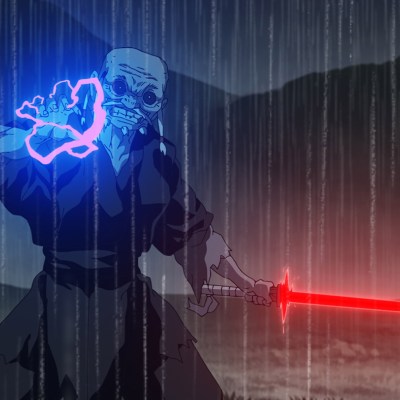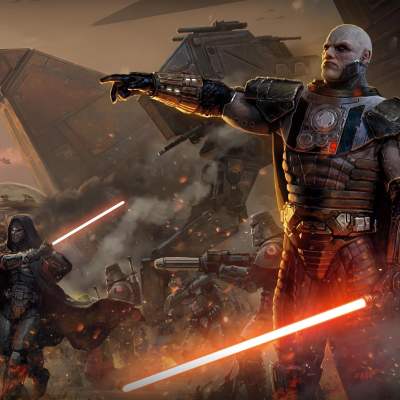How the Best Star Wars Visions Episodes Subvert the Story of Luke and Leia
"Twins" and "Lop and Ocho" are two of Star Wars: Visions' best episodes, partly due to the way they reinterpret the classic Luke and Leia story.

This Star Wars: Visions article contains spoilers.
At the center of Star Wars sit the twins. A cornerstone of the Original Trilogy, Luke and Leia are also the template for some of the shorts in the Star Wars: Visions anime anthology. The episode “The Twins” takes this concept the most literally, presenting twins born for a specific purpose, whether or not they fulfill it. But it’s another episode, “Lop and Ochō,” which truly takes the “Force siblings” concept to another level. It’s similar enough to be recognizably Star Wars, while also breaking new ground.
Luke and Leia, the brotherly bond between Anakin and Obi-Wan, and Jaina and Jacen Solo in the old Legends canon — Star Wars‘ Skywalker family drama is built around stories about blood or adopted siblings. The first major difference in “Lop and Ochō” is that it’s a story about sisters. But that’s not the only reason it stands out.
Like the other anime shorts, which run from 10-20 minutes each, it does a lot with very little. Lop is rescued by Ochō and her father from a life on the streets of Tao. She was brought to their planet as a slave by the Empire, and her knowledge of its oppression is tested years later when she’s forced to choose a side. As the presumed heir of the family, Ochō believes the Empire can help their planet prosper through increased industrialization. But their father isn’t so sure, and is concerned about how the Empire’s plan will erase the planet’s natural resources and beauty. In the end, Lop chooses nature over industry, and the clash with Ochō is a compelling drama (with a cool lightsaber duel featuring an ancient “sword” that is a family heirloom). Unlike the tale of Luke and Leia in the Original Trilogy, it has a sad ending.
Stream your Star Wars favorites right here!
In “Lop and Ochō,” the stakes are both large and small, the character interactions tied to both the individual people and the larger themes. Ochō’s reasoning for joining the Empire comes from a genuine place of compassion for her family, but is twisted by the perception that greed is the only way to achieve safety and prosperity. As well as a fight between two sisters, it’s also a fight between callous “practicality” and only-somewhat-effective idealism. Meanwhile, Lop, the adopted child, becomes her father’s true heir, earning the right to wield the family’s most prized possession.
Like many of the episodes in the anthology, the lightsaber plays a central role. Lop’s father says it directly: “This ancient weapon represents the bond between parent and child.” Along with the idea of a lightsaber as an ancestral sword — and using both a lightsaber and an ancestral sword — being extremely cool, this also directly revisits a theme that has been gestured at throughout Star Wars. Look at the associations Luke, Obi-Wan, and Rey all have with Anakin’s weapon. The lightsaber doesn’t have any power of its own, but it is a reminder of the other people who wielded it and how they’re all connected, as dysfunctional as their Force family may be.
“I would say with ‘Lop and Ochō,’ that one is more of a found family story and the tension and dynamics of different perspectives in family. Which feels very Star Wars to me,” executive producer James Waugh tells Den of Geek.
With a heart-wrenching “I am your father,” Darth Vader’s revelation to Luke became one of the most famous (and misquoted) movie lines in history. In “Lop and Ochō,” it’s used in a different way. Not just a funny reference, Lop’s father’s repetition of the line drives home the idea that although they are different species, they are true family and willing to risk their lives for each other. Instead of a horrible revelation, it’s a comforting one. Placing the line in such a different emotional context is what makes it more than an easter egg.
In regards to stories about family creating the backbone of the franchise (and the subversion thereof), Waugh says that “the celebratory nature of Visions in general, of taking elements that meant something to you from the Star Wars galaxy and finding your own way to express that, really unlocked [that subversion].”
“The Luke-Leia twins story is so fundamental to your first steps to learning about the galaxy and understanding Star Wars,” he continues. “So to take something like ‘The Twins,’ what’s beautiful about that short to me is it feels like it’s such a product of remix culture. It feels like it is remixing Star Wars ideas in a really fresh, unique way. Taking known ideas and then subverting them, and putting them together in a really unique collage that all the ideas are instantly recognizable, but they’re done differently.”
In “The Twins,” we meet Karre and Am, twins who have been raised as children of the dark side by the Imperial remnant, who hope they’ll one day grow up to rule the galaxy as one. But when Karre begins to question the path that’s been set out for him, it causes a rift with Am that plays out in one of the wildest action sequences in Star Wars history. Despite being raised as a “chosen one,” Karre chooses something different, which producer Kanako Shirasaki pinpoints as the message of the episode.
“You can find the message from the creators, [Trigger] really wanted to tell the younger audience or younger generation that you pursue what you want to do, like Karre he was coming from a very specific background and becoming kind of nobody. You feel very moved by the story because there’s a very strong message from the creators you can find on top of the Star Wars element and Star Wars storytelling.”
It’s likely no accident that “The Twins” and “Lop and Ochō” feel more open-ended than some of the other shorts, and that, too, adds to their appeal. They aren’t wrapped up neatly, the conflicts between these siblings are left in a messy place. Like “The Duel,” which became the inspiration for a full-length novel out in October, these two shorts feel like they could expand outward into whole new sagas. Sometimes, when it comes to Star Wars, evoking that feeling is the real sign of success.



